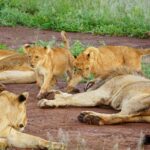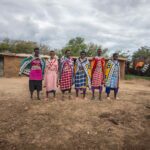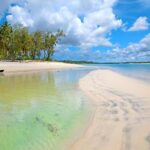Having no less than 32 national parks, which cover almost one-third of the country’s total area, Tanzania offers some of the best safari destinations found anywhere in the world.
Within these vast spaces of pristine wilderness and breathtaking beauty lives a wide selection of wildlife, which draws millions of nature lovers and other tourists to Tanzania year after year. And those visiting during the peak season can also witness the height of one of nature’s most incredible spectacles – the Great Wildebeest Migration.
Tanzania’s national parks are split into two regions, known as the Northern and Southern Safari Circuits. The northern ones are the most popular and are far easier to get to. Some are incredibly vast, while others are tiny and compact, but they all have something interesting and unique to offer.
To truly experience the magic of Tanzania’s parks, they are best visited during the long dry season, which runs from June to October each year. The weather is at its best during this period, with sunny skies, little chance of rain, and abundant wildlife. It also coincides with the Great Migration in the Serengeti.
With so many options to choose from, visitors to Tanzania may sometimes feel overwhelmed with all the options available. Deciding which parks to visit and what you can expect to see in each park is not an easy task, especially for first-time visitors.
So, to make things easier for you, here is my list of the best safari locations in Tanzania and the reasons why you should visit them.
The Best Safari Locations in Tanzania
Tarangire National Park

Situated on the Northern Circuit, Tarangire is undoubtedly the best place to see elephants, and in huge numbers, too. It has some of the biggest herds of these giants in Africa, some reaching over 100 strong. Observing them moving through the forests as a unit is simply too marvellous for words.
Tarangire has a relatively dry climate consisting of vast, tall, green, and yellow grasslands, dense woodlands, and wetlands. It is also characterised by its red, dusty soils, huge granite promontories, and massive ancient baobab trees.
The wildlife here is as diverse as the landscapes. Apart from impressive herds of elephants, you’ll find no shortage of lions, leopards, cheetahs, buffalos, zebras, giraffes, wildebeest, eland, kudu, impala and various other buck species. You might even spot the rare gerenuk and other rare subspecies of oryx that are not found in many other places. Unfortunately, there are no rhinos here.
The Tarangire River, which flows through most of the park, and the wetlands, which take up much of the park’s centre, hold a sizable population of hippos, crocodiles, and over 500 species of birds. These include spoonbills, hornbills, pelicans, herons, and massive colonies of flamingos.
Although Tarangire is far smaller than the famous Serengeti, it is large enough to hold its own mini-migration during the dry season when thousands of herbivores, including elephants, head north searching for water and fresh grasses to feed on.
Ample accommodation is offered both inside and outside the park, making it an easily accessible safari park.
Ruaha National Park

Moving on to the Southern Circuit, Ruaha is one of the biggest national parks in Tanzania. However, as it’s a little off the beaten path, it’s more suited to adventurous travellers or those who prefer a quieter but wilder safari experience.
Being over 20,000 km² (7,800 mi²) in size, you would need to spend a good few days to truly soak up the tranquillity of this animal-rich wilderness. However, while Ruaha boasts rich, remote landscapes and fewer visitors, in turn this park is more expensive than the popular alternatives on the Northern Circuit. That said, if a less rushed and uncrowded safari is what you want, the experience here is unmatched and worth every cent you pay and every effort you make.
Ruaha is known for its large prides of lions, some of which may be up to 20 strong. It also has a large population of elephants, buffaloes, leopards, cheetahs, hippos, crocodiles, zebras, giraffes and many antelope species. It’s one of the few places in Tanzania where you have a chance of seeing African wild dogs. Here, too, there are no rhinos.
Getting to Ruaha requires covering some serious distances by road, but most people choose to fly here from Arusha, Dodoma, or Dar es Salaam. Planes land at one of the few airstrips in the area, and you must drive for another 2-3 hours to reach your selected lodge.
Serengeti National Park

The Serengeti is Tanzania’s flagship park and possibly the world’s most famous game park. Covering a massive area of 14,763 km² (5,700 mi²), it forms part of the Mara/Serengeti Ecosystem, which it shares with neighbouring Kenya. If you could only visit one park in your life, The Serengeti National Park would be it.
All the Big Five are found here in huge numbers throughout the year, but sightings of rhinos are extremely rare, as in many parks across Africa. Other animals you’ll see in abundance include cheetahs, hyenas, jackals, giraffes, impalas, hippos, warthogs and over 500 species of birds.
Within this vast area, you’ll find various ecosystems, each with its own variety and density of wildlife, which vary seasonally.
From December to February, the plains in the southern regions are filled with thousands of newborn herbivores arriving each day, drawing out vast numbers of big cats and other predators.
But it is when the massive herds of wildebeest, zebras and antelope set off on their epic journey to the north that this park truly comes alive; the sight of 2 million animals moving across the plains is something you have to see to believe! Around July and August, the herds can be seen crossing the Grumeti River, where the largest Nile crocodiles are eagerly waiting for their annual feast.
From September onwards, the migrating herds reach the northern region of the Serengeti. Here, they must prepare to cross their most perilous obstacle – the infamous Mara River, where thousands of hungry crocodiles lie in anticipation of the feast.
Depending on the arrival of the rains, by October and November, the herds return to the southern plains to graze on green grasses and give birth before repeating the annual journey.
Ngorongoro Crater

When it comes to natural beauty, the Ngorongoro Crater is unmatched—this sublime park is one of nature’s greatest gifts to Africa.
The caldera formed millions of years ago when a volcano collapsed inwards on itself. The event created a circular caldera covering 260 km² (100 mi²), in which 25,000 animals live. The 610-metre (2,000-ft) high crater wall, which extends 19 km (12 miles) across, effectively traps them. The views from the crater rim are simply breathtaking.
Within this relatively small area, you’ll find most of the animals you expect to see across Africa, including endangered black rhinos, with the exception of giraffes and crocodiles. The Big Five are abundant here, with lions and cheetahs seen almost everywhere. Leopards, too, are abundant but are not always spotted due to their shy nature, spending much of the day hidden in the thickets, usually up in the trees. Like most cats, they do most of their hunting after dark.
The abundance of zebra, impala and wildebeest provides ample food for all of Ngorongoro’s predators. At the same time, the absence of any substantial migration means you can visit Ngorongoro all year round. The lake in the middle of the crater is a magnet for millions of birds, including many aquatic species like pelicans and flamingos.
As Ngorongoro is situated between Tarangire and Serengeti National Parks, it’s easy and convenient to visit all three parks on one itinerary, providing a truly unforgettable safari experience.
Lake Manyara National Park

Lake Manyara lies neatly tucked in between Tarangire and Ngorongoro, and due to its small size, it can also be visited in a single day. This park is slightly larger than the Ngorongoro Crater, but Lake Manyara takes up much of the area, and the water attracts wildlife and makes animals easier to spot.
Although the lake has expanded due to recent heavy rainfall, it still contains an abundance of animals, with its famous tree-climbing lions being the stars of the park. While lions are known to climb trees periodically in many places in Africa, they seem to have evolved to do so regularly here.
Other animals you can expect to find here include leopards, elephants, buffalos, zebras, giraffes, wildebeest, warthogs, baboons, waterbuck and other antelopes. The lake teems with hippos and vast colonies of flamingos and other aquatic bird species.
Aside from the brilliant wildlife, excellent trails lead to waterfalls, and several high viewpoints offer stunning views of the lake and park. The lake’s shallow waters also provide exceptional canoe safaris.
Nyerere National Park

Situated in the remote regions of the Southern Circuit, Nyerere is Africa’s largest national park, covering an area far exceeding that of Switzerland. Like Ruaha National Park, getting to Nyerere takes some effort, as it is in a far-off and isolated region of Tanzania. However, it is only 200 km (125 mi) from Dar es Salaam.
Considering the effort and costs of getting here, it is well worth it. However, you would ideally need a good few days to explore its majestic landscapes and rich wildlife. The terrain is similar to Ruaha, but more water is available in the form of rivers, tributaries, watering holes, wetlands, and the mighty Rufiji River, which flows across the park’s northern section.
Nyerere has a similar range and abundance of game as Ruaha and can also boast of having black rhinos. Although sightings of these heavily poached creatures are never a given, they are a pleasant surprise to see in the wild. Nyerere also has around 1,000 wild dogs and is one of the best places in Tanzania to see these highly intelligent canines. The numerous water sources attract over 400 species of birds.
The Rufiji River provides fantastic luxurious lodging and superb boating cruises, allowing you to view hippos, crocs, and rich birdlife from a different vantage point. Lodges also offer fantastic fishing trips along this river, with the primary target being the ferocious-looking tigerfish.
Gombe Streams National Park

Gombe is undoubtedly one of the most difficult parks to reach in Tanzania. It’s situated in the extreme western region of the country, between the Gombe Mountains and the shores of Lake Tanganyika. Getting there by road will be a monumental adventure, and the time is measured in days rather than hours. However, it is much easier to reach by air for those who can afford the costs.
Although there are some predators and a few other species like leopards, buffalos, and bush pigs to be seen in and around the dense forests, the real stars and the main attractions here are its chimpanzees. Made famous by the work done by Jane Goodall since the 1960s, this park is synonymous with chimpanzee research across the world. Most people who take the trouble to come here come for one reason only – to trek into the forest and observe these super-intelligent creatures in the wild.
Meanwhile, the clear waters of Lake Tanganyika offer spectacular beach activities like swimming, fishing, and snorkelling. You’ll need to seek advice from local guides and stick to certain areas only, as hippos and crocs also pop up from time to time. Yes, this is Africa, after all.
Conclusion
So there you have it: the top seven national parks in one of the world’s top safari destinations! And wherever you decide to go, we’re sure that visiting Tanzania will be an adventure you never forget.
Collectively, these brilliant parks provide some of the best wildlife encounters you could ever hope to experience, and you’ll soon see why Tanzania is such a beloved country.
For more similar articles about Tanzania, check out my recommendations below:
- How much does a safari in Tanzania costs?
- What to expect from a budget safari in Tanzania?
- Camping in Serengeti National Park
Like it? Pin it!

Disclaimer: Some of the links on this website are “affiliate links.” This means that if you click on the link and do a purchase, I will receive an affiliate commission at no extra cost for you. This helps me keep my website running and continue to share my travelling knowledge with you. I thank you for booking your flights or hotels using the links on my website. Regardless, I only recommend products or services I use personally and believe will add value to my readers.




